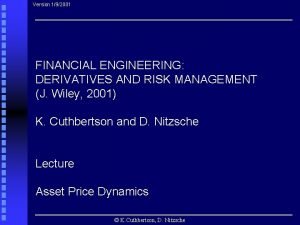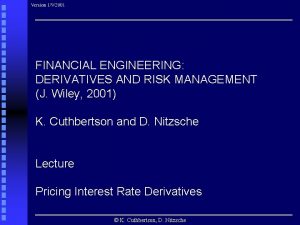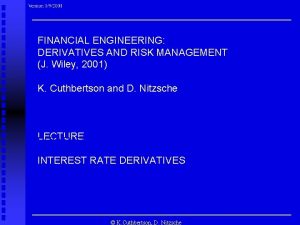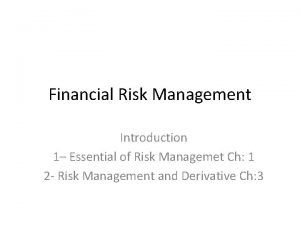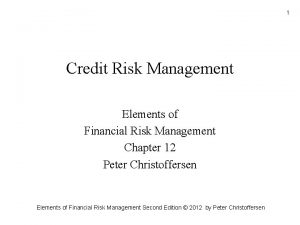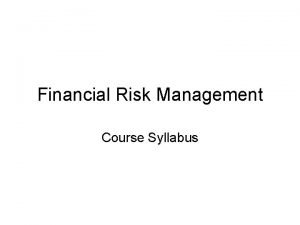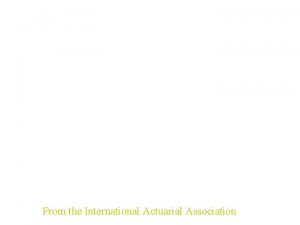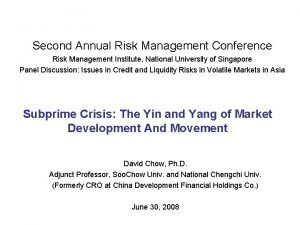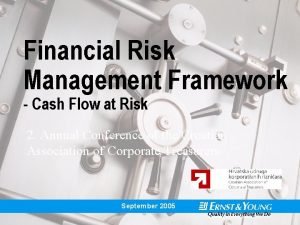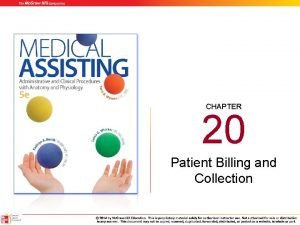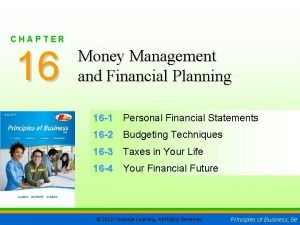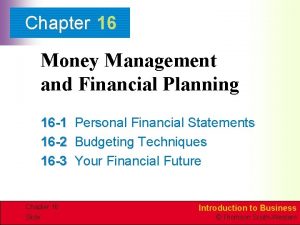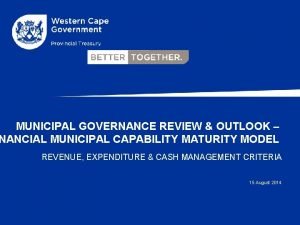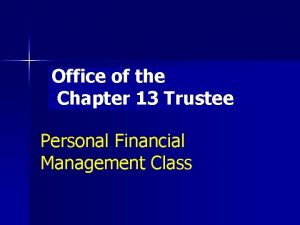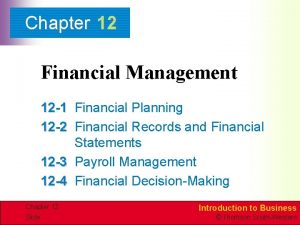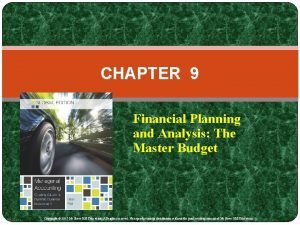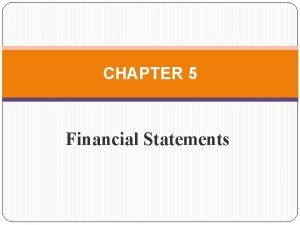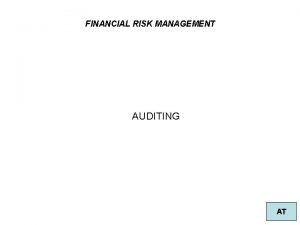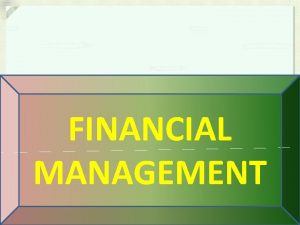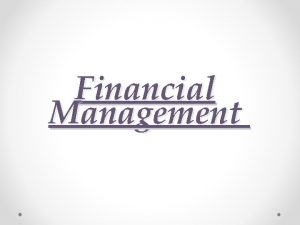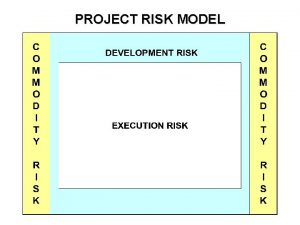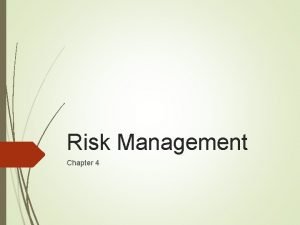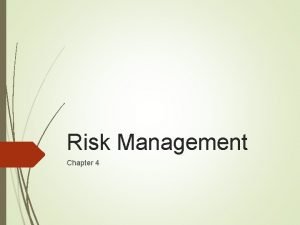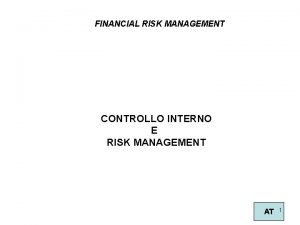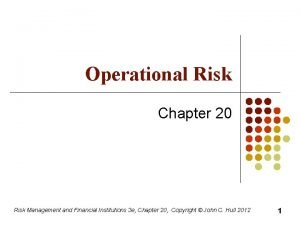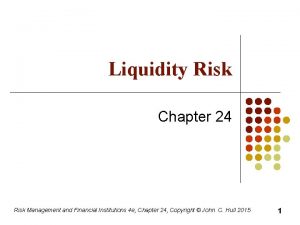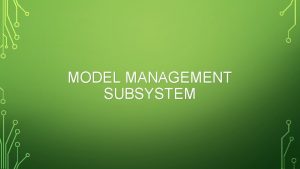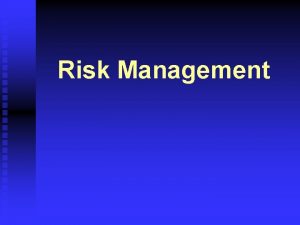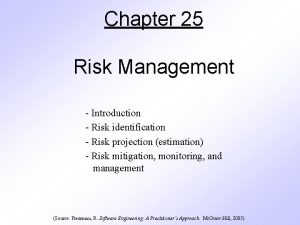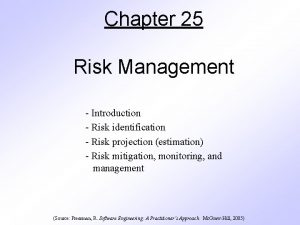Model Risk Chapter 22 Risk Management and Financial






















- Slides: 22

Model Risk Chapter 22 Risk Management and Financial Institutions 3 e, Chapter 22, Copyright © John C. Hull 2012 1

Marking the Prices of an Instrument to Market l l l Use price quoted by market maker (usually financial institutions mark to mid of bid and offer) Use price at which financial institution has traded product Use interdealer broker prices Use interdealer price indications Use model (marking to model) Risk Management and Financial Institutions 3 e, Chapter 22, Copyright © John C. Hull 2012 2

Accounting l l FASB 157 and IASB 39 classify instruments as “held for sale” or “held to maturity” Those classified as held for sale have to be marked to market l l l Level 1: uses quoted prices in active markets Level 2: uses quoted prices for similar product in active markets or same product in non-active markets Level 3: requires valuation assumptions Risk Management and Financial Institutions 3 e, Chapter 22, Copyright © John C. Hull 2012 3

Controversial Changes in 2008 and 2009 l l Banks can in rare circumstances reclassify instruments from “held for sale” to “held to maturity” and vice versa Banks can use model prices in preference to market prices when they judge market prices do not represent fair value Risk Management and Financial Institutions 3 e, Chapter 22, Copyright © John C. Hull 2012 4

Model Risk Can Lead To… l l Incorrect price at time product is bought or sold Incorrect hedging Risk Management and Financial Institutions 3 e, Chapter 22, Copyright © John C. Hull 2012 5

Finance vs Physics (page 476) l l The models of physics describe physical processes and are highly accurate. Their parameters do not change through time. The models of finance describe human behavior. They are at best approximations. Parameters do change through time Risk Management and Financial Institutions 3 e, Chapter 22, Copyright © John C. Hull 2012 6

Calibration l l l Models of finance are calibrated to market prices daily As a result parameters change from day to day For a particular option maturing in three months volatility might be 20% on Day 1, 22% on Day 2, and 19% on Day 3. Risk Management and Financial Institutions 3 e, Chapter 22, Copyright © John C. Hull 2012 7

The Way Models Are Usually Used in Finance Observe model prices for similar instruments that trade Imply model parameters. Interpolate as appropriate Value new instrument Risk Management and Financial Institutions 3 e, Chapter 22, Copyright © John C. Hull 2012 8

Linear Products l l Very little uncertainty about the right model But mistakes do happen. For example… l l Kidder Peabody (Business Snapshot 22. 1, page 476) LIBOR-in Arrears Swaps (Business Snapshot 22. 2, page 477) Risk Management and Financial Institutions 3 e, Chapter 22, Copyright © John C. Hull 2012 9

Standard Products l l l We do not need usually a model to know the price of an actively traded product. The market tells us the price. The model is a communication tool (e. g. , implied volatilities are quoted for options) It is also an interpolation tool (e. g. , a tool for interpolating between strike prices and maturities. Risk Management and Financial Institutions 3 e, Chapter 22, Copyright © John C. Hull 2012 10

Volatility Smiles l l A volatility smile shows the variation of the implied volatility with the strike price The volatility smile should be the same whether calculated from call options or put options Risk Management and Financial Institutions 3 e, Chapter 22, Copyright © John C. Hull 2012 11

The Volatility Smile for Foreign Currency Options (Figure 22. 2, page 480) Implied Volatility Strike Price Risk Management and Financial Institutions 3 e, Chapter 22, Copyright © John C. Hull 2012 12

The Volatility Smile for Equity Options (Figure 22. 3, page 480) Implied Volatility Strike Price Risk Management and Financial Institutions 3 e, Chapter 22, Copyright © John C. Hull 2012 13

Volatility Term Structure l l In addition to calculating a volatility smile, traders also calculate a volatility term structure This shows the variation of implied volatility with the time to maturity of the option Risk Management and Financial Institutions 3 e, Chapter 22, Copyright © John C. Hull 2012 14

Example of a Volatility Surface (Table 22. 1, page 482) Risk Management and Financial Institutions 3 e, Chapter 22, Copyright © John C. Hull 2012 15

Official vs Research Models l It is important to distinguish between l l A financial institution’s official model for a product, which is should be designed to track market prices as closely as possible Research models, which are designed to develop trading strategies Risk Management and Financial Institutions 3 e, Chapter 22, Copyright © John C. Hull 2012 16

Hedging Actively Traded Products l l Models are used in a more significant way for hedging than for pricing We can distinguish “within model” hedging from ”outside model” hedging Risk Management and Financial Institutions 3 e, Chapter 22, Copyright © John C. Hull 2012 17

P&L Decomposition (page 485) Distinguishes between: l P&L changes from risks that were unhedged l P&L changes from the hedging model being imperfect l P&L changes from new trades done during day Risk Management and Financial Institutions 3 e, Chapter 22, Copyright © John C. Hull 2012 18

Models for Nonstandard Products (page 485) l l In the case of nonstandard models play a key role in both pricing and hedging It is a good idea to use more that one model whenever possible Risk Management and Financial Institutions 3 e, Chapter 22, Copyright © John C. Hull 2012 19

Model Audit Groups l Model audit groups within a bank l l l Check that a model has been implemented correctly Examine whethere is a sound rationale for the model Compare the model with others that can accomplish the same task Specify limitations of model Assess uncertainties in prices and hedge parameters given by model Risk Management and Financial Institutions 3 e, Chapter 22, Copyright © John C. Hull 2012 20

Dangers in Model Building (page 486) l l Overfitting Overparametrization Risk Management and Financial Institutions 3 e, Chapter 22, Copyright © John C. Hull 2012 21

Detecting Model Problems (page 487) l l Monitor types of trading a financial institution is doing with other financial institutions Monitor profits being recorded from trading of different products Risk Management and Financial Institutions 3 e, Chapter 22, Copyright © John C. Hull 2012 22
 Fiduciary investment risk management association
Fiduciary investment risk management association Financial management chapter 8 risk and return
Financial management chapter 8 risk and return Business risk vs financial risk capital structure
Business risk vs financial risk capital structure Financial engineering derivatives and risk management
Financial engineering derivatives and risk management Financial engineering derivatives and risk management
Financial engineering derivatives and risk management Financial engineering derivatives and risk management
Financial engineering derivatives and risk management Market risk assessment
Market risk assessment What is financial risk 1
What is financial risk 1 Elements of credit risk management
Elements of credit risk management Financial risk management syllabus
Financial risk management syllabus Enterprise risk management for financial institutions
Enterprise risk management for financial institutions Financial risk management conference 2018
Financial risk management conference 2018 Financial risk management framework
Financial risk management framework The process of classifying and reviewing past due accounts
The process of classifying and reviewing past due accounts Chapter 16 money management and financial planning
Chapter 16 money management and financial planning Chapter 16 money management and financial planning
Chapter 16 money management and financial planning Risk map risk management
Risk map risk management Non financial methods of motivation
Non financial methods of motivation Fmcmm
Fmcmm Chapter 13 personal financial management course
Chapter 13 personal financial management course Chapter 12 financial management
Chapter 12 financial management Chapter 9 financial management
Chapter 9 financial management Corporate financial reporting objectives
Corporate financial reporting objectives



